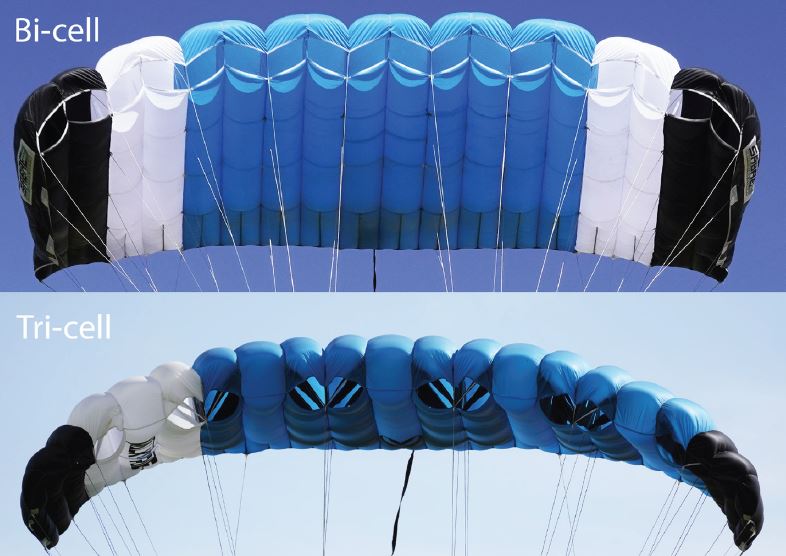 Brought to you by Niklas Daniel and Brianne Thompson of AXIS Flight School at Skydive Arizona in Eloy. Images by Niklas Daniel. For more skydiving educational content and professional coaching services, visit axisflightschool.com.
Brought to you by Niklas Daniel and Brianne Thompson of AXIS Flight School at Skydive Arizona in Eloy. Images by Niklas Daniel. For more skydiving educational content and professional coaching services, visit axisflightschool.com.
For review, check out “Foundations of Flight: Ram-Air Parachute Anatomy—Airfoil” (which includes a discussion of ribs) in the September 2021 issue of Parachutist (available under the back issues tab at parachutist.com).
Definition and Purpose
Cross-bracing is a design feature found mostly on smaller, high-performance wings. Adding extra angled ribs between the vertical ones spreads the suspended load under a parachute span-wise throughout the wing. This reduces undesirable shape distortions in flight, increasing efficiency and performance. In appearance, this subdivides a cell (now a “tri-cell”) into smaller triangular sections (turning a seven-cell canopy into 21-cell canopy, for example). Cross-bracing acts like longitudinal trussing, which provides the wing with greater strength and stability. You can see this construction method applied in structural engineering any place where loads must be supported over large spans of space, such as bridges, roofs and much more.
 Comparison of a bi- and tri-cell (cross-braced) design.
Comparison of a bi- and tri-cell (cross-braced) design.A Design Perk
Because cross-bracing distributes a jumper’s weight over a greater span, fewer suspension lines are needed in the parachute’s design. On a cross-braced canopy, only every third rib is loaded, as opposed to every other rib on a non-cross-braced canopy. This allows for drag reduction to make the parachute fly more efficiently. Imagine holding your suspension lines in one hand and noticing the diameter of the combined bundle. Shrinking this diameter by removing lines and/or using thinner lines cuts down on drag.
Drawbacks
Though cross-bracing offers many advantages in flight, it has some drawbacks. Because more material is used during construction and the design is more time and labor-intensive, costs are significantly increased. In addition, more material increases the overall pack volume by as much as 20-25% compared to the equivalent size of a non-cross-braced design. Therefore, cross-bracing is used primarily in smaller wings. For additional rigidity, some manufacturers offer wings made from a stiffer sailcloth material. This may be a complete or a partial hybrid build (e.g., only the ribs could be sailcloth, while the rest is regular zero-porosity fabric). While sailcloth may give the pilot more sensitive handling characteristics and better stopping power, this too increases the pack volume.
Who Is It For?
At this point, you may be asking, “Is this for me? What are the recommended prerequisites for jumping a cross-braced canopy?”
Cross-bracing is advantageous for pilots who fly at high wing loadings, where drag becomes a significant factor in degrading performance. Generally, cross-bracing appeals to those who perform induced-speed landings. Before trying a cross-braced canopy, make sure you are completely familiar with all advanced landing characteristics and techniques in a variety of weather conditions on your current wing.
Get personalized, expert advice from professional canopy coaches who have properly assessed your circumstances. The emphasis should be on increasing performance first and foremost through skill. It is better to grow out of a canopy than to grow into one. Lastly, explore only one new design element with all recommended maneuvers at a time until you are competent in their application.
Information about AXIS’ coaching and instructional services is available at axisflightschool.com. The authors intend this article to be an educational guideline. It is not a substitute for professional instruction.